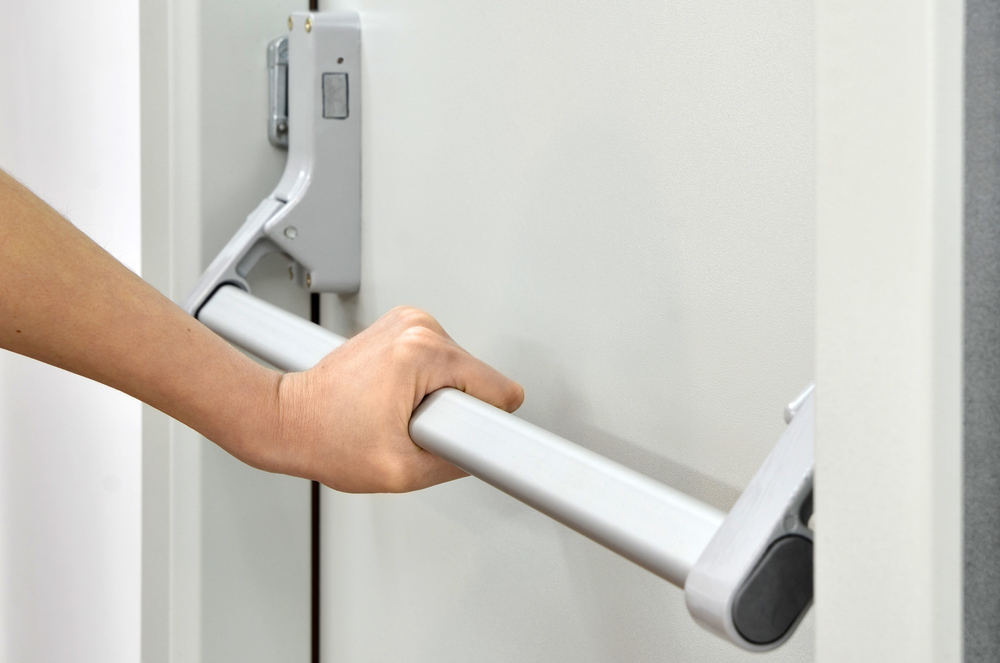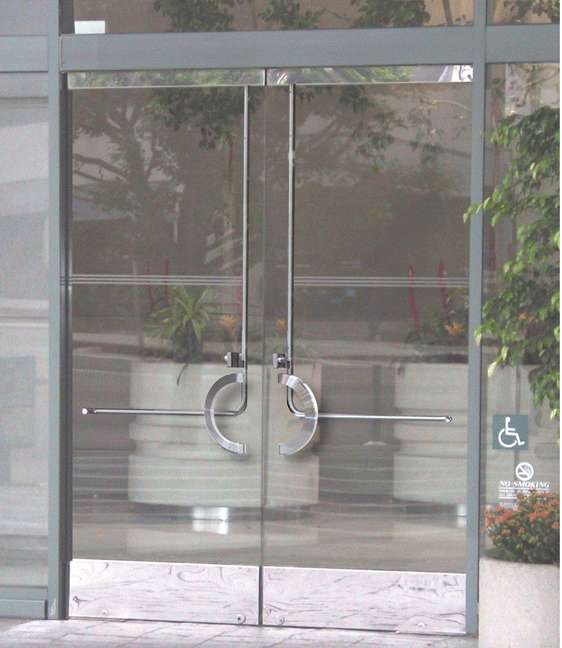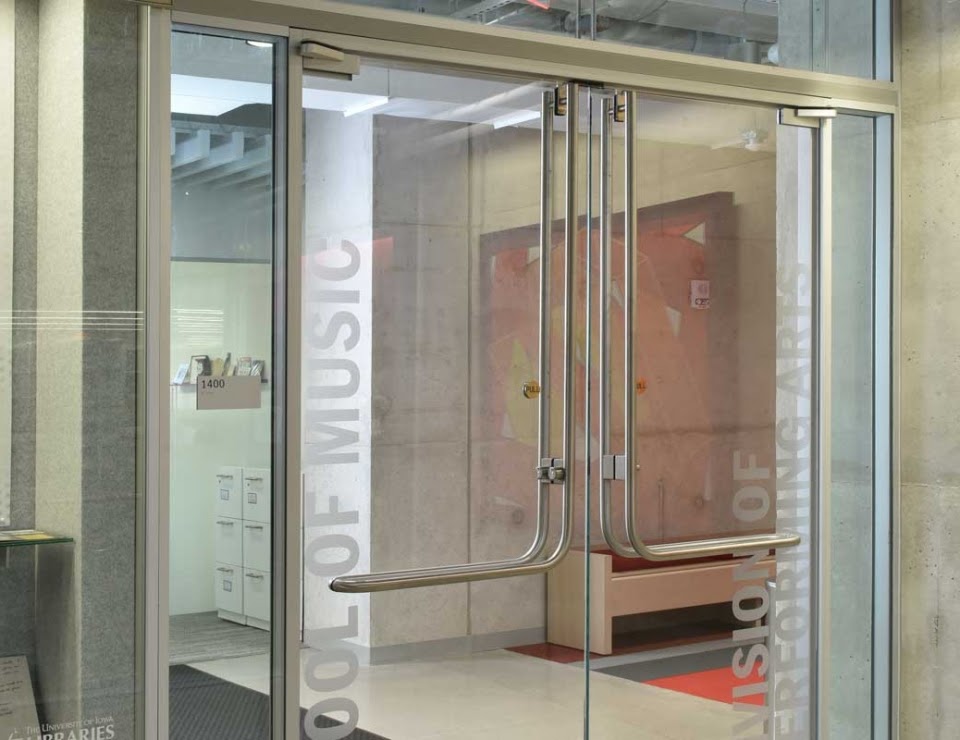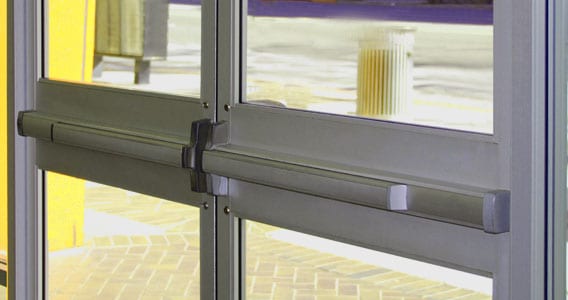Panic Hardware On Glass Doors
When it comes to commercial properties, safety and security are of utmost importance. Panic hardware on doors is a crucial component of any emergency response plan in a commercial building. Not only does it allow for timely and safe evacuation in case of emergencies, but it also ensures compliance with building codes and regulations. In this post, we will take a closer look at the importance of panic hardware and the types of panic hardware available.
What is Panic Hardware?
Panic hardware, also known as crash bars, push bars, or panic exit devices, are mechanisms that allow for safe and quick exit in case of emergencies. They are installed on doors that are expected to be used for emergency exits or doors that have high occupancy levels.
A typical panic hardware system consists of a horizontal bar that spans the width of the door, mounted at a height of 41 inches above the finished floor, and a vertical rod that activates the locking mechanism of the door. When the horizontal bar is pushed, the door opens immediately, without the need for any special knowledge, effort or hardware to unlock the door.
Why Panic Hardware is Important?
Panic hardware plays a critical role in ensuring the safety and security of people in commercial properties. In case of emergencies, such as fire, natural disasters, or terrorist attacks, people need to evacuate the building quickly and safely. Traditional doors with locks and keys can be difficult to open under high pressure and stress, and can lead to injuries, fatalities or legal liabilities for the property owners or managers.
Panic hardware ensures that doors open immediately when pushed, without requiring any particular effort, knowledge or hardware. It allows for easy and safe evacuation for users, including people with disabilities, children, elderly or injured people. In addition, panic hardware reduces the risk of panic and stampedes, as it provides a clear and visible exit path for everyone to follow.
Moreover, panic hardware is mandated by laws and regulations at local, state and federal levels. Many building codes require commercial buildings to have panic hardware on doors that qualify as exit doors or doors that lead to emergency exits or assembly areas. Regular inspections and maintenance of panic hardware are also required to ensure their proper functioning and compliance. Failure to comply with panic hardware requirements can lead to fines, penalties, lawsuits or even closure of the business.
Types of Panic Hardware
Panic hardware comes in different types and configurations, depending on the type of door, the level of occupancy, the level of safety required and the aesthetics of the building. Some common types of panic hardware include:
1. Vertical Rod Panic Devices:
Vertical rod panic devices are typically used on narrow doors, double doors or doors with windows. They consist of a vertical rod that spans the height of the door and is attached to the door, and a latch that secures the door to the frame. When the panic bar is pushed, the vertical rod is activated, and the latch is disengaged, allowing the door to swing freely.

Vertical rod panic devices are available in rim or mortise versions, depending on the type of lock cylinder used. They are suitable for high traffic areas, as they can withstand frequent use and abuse, and have a longer lifespan than other types of panic hardware.
2. Rim Panic Devices:
Rim panic devices are typically used on single doors or doors with a low traffic volume. They consist of a panic bar that spans the width of the door, and a latch that secures the door to the frame. When the panic bar is pushed, the latch is disengaged, allowing the door to open.

Rim panic devices are easier to install and maintain than vertical rod devices, but they are more vulnerable to abuse and wear and tear. They are also less suitable for doors with windows or narrow frames, as they can interfere with the window or frame.
3. Mortise Panic Devices:
Mortise panic devices are typically used on doors that require additional security, such as healthcare facilities, data centers or financial institutions. They consist of a panic bar that spans the width of the door, and a lock cylinder that is integrated into the door. When the panic bar is pushed, the lock cylinder is activated, and the door is unlocked.
Mortise panic devices are more secure and tamper-resistant than other types of panic hardware, but they are also more expensive and require professional installation and maintenance.
Conclusion
Panic hardware is an essential component of any emergency response plan in commercial properties. It allows for timely and safe evacuation in case of emergencies, ensures compliance with building codes and regulations, and reduces the risk of injuries, fatalities or legal liabilities. There are different types of panic hardware available, depending on the type of door, the level of occupancy, the level of safety required and the aesthetics of the building. Regular inspections and maintenance of panic hardware are required to ensure its proper functioning and compliance.
As a property owner or manager, it is important to invest in quality panic hardware and to educate the staff and tenants about its proper use and maintenance. By doing so, you can provide a safe and secure environment for everyone in your commercial property.
If you are looking for Panic devices for glass entrances: overcoming design and specification you've visit to the right place. We have 7 Pics about Panic devices for glass entrances: overcoming design and specification like How to Select Glass Panic Doors for Commercial Spaces | Avanti Systems, Glass Door Panic System PL 100 Top Latching Panic Device – PRL Glass and also I Dig Hardware » QQ: Can panic hardware be installed on a door that. Here you go:
Panic Devices For Glass Entrances: Overcoming Design And Specification
 www.constructionspecifier.com
www.constructionspecifier.com panic blumcraft glass devices door hardware laurence doors cr overcoming entrances specification challenges archdaily catalog indigo hotel
Glass Door Panic System PL 100 Top Latching Panic Device – PRL Glass
 www.glassdoorpanicsystem.com
www.glassdoorpanicsystem.com glass panic door exterior handles handle custom system doors hardware herculite entrance pl fittings device systems pulls tvs header
Does All Commercial Properties Need Panic Hardware On Their Doors?
 longmontlocksmith.us
longmontlocksmith.us panic exit door hardware doors commercial emergency fire locks lock locksmith device security devices push planning installation does need egress
How To Select Glass Panic Doors For Commercial Spaces | Avanti Systems
 www.avantisystemsusa.com
www.avantisystemsusa.com door exit avanti pivot
Panic Hardware | NYC Doors And More
 nycdoorsandmore.com
nycdoorsandmore.com panic hardware door doors push repair bar admin feb comments commercial
I Dig Hardware » QQ: Can Panic Hardware Be Installed On A Door That
exit panic hardware door installed lead doors qq dig doesn idighardware
Glass Panic & Exit Doors| Panic Bars | Avanti Systems USA
 www.avantisystemsusa.com
www.avantisystemsusa.com panic glass doors door exit bars
Exit panic hardware door installed lead doors qq dig doesn idighardware. Panic hardware door doors push repair bar admin feb comments commercial. Panic exit door hardware doors commercial emergency fire locks lock locksmith device security devices push planning installation does need egress
Post a Comment for "Panic Hardware On Glass Doors"